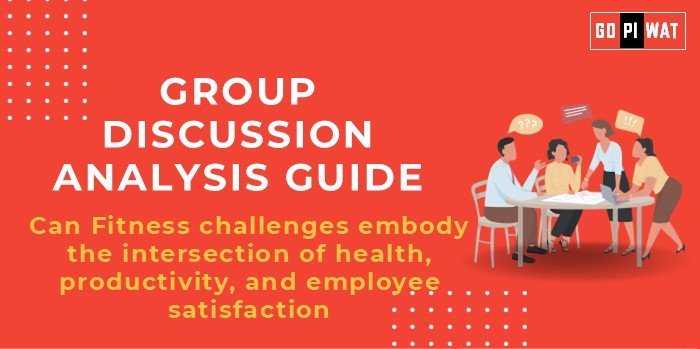📋 Group Discussion (GD) Analysis Guide
🌐 Introduction to Workplace Fitness Challenges
Opening Context: As sedentary lifestyles dominate workplaces globally, fitness challenges emerge as a dynamic solution to promoting health and productivity. This aligns with increasing awareness of wellness and corporate responsibility.
Topic Background: Initiatives such as step-count competitions, wellness rewards, or team fitness goals aim to foster a culture of health. Popular in companies like Google and Microsoft, these challenges have proven benefits but also raise concerns about inclusivity and sustainability.
📊 Quick Facts and Key Statistics
- Workplace Sedentary Impact: Employees spend 9+ hours sitting daily on average, leading to health risks like obesity and cardiovascular issues.
- Corporate Wellness Programs: 60% of global companies offer fitness-related initiatives. (Source: Global Wellness Institute, 2023)
- Participation Metrics: 70% of employees in active programs report increased motivation.
- ROI on Wellness: For every $1 invested in wellness, companies save $3 in healthcare costs.
- Global Trend: Fitness challenges gained traction, especially post-COVID, with a 40% rise in digital fitness app adoption in workplaces.
👥 Stakeholders and Their Roles
- Employees: Beneficiaries of improved physical and mental health, potentially leading to better work performance.
- Employers: Drive these initiatives to enhance productivity and reduce absenteeism.
- Healthcare Providers: Offer wellness resources, consultations, and fitness programs.
- Tech Companies: Develop apps and wearables for tracking fitness.
- Governments and NGOs: Advocate workplace health policies.
🏆 Achievements and Challenges
Achievements:
- Productivity Boost: Healthier employees are 21% more productive (Gallup, 2023).
- Team Bonding: Collaborative challenges strengthen workplace relationships.
- Cost Reduction: Wellness programs cut absenteeism by 25%.
- Global Example: Sweden integrates mandatory workplace fitness hours into daily schedules.
Challenges:
- Participation Bias: Only 30% of inactive employees engage in such programs.
- Inclusivity Issues: Fitness challenges may unintentionally exclude older or differently-abled workers.
- Global Comparison: Japan’s “Metabo Law” mandates health checks but has faced resistance due to privacy concerns.
📂 Structured Arguments for Discussion
- Supporting Stance: “Fitness challenges enhance workplace morale and reduce health costs, fostering a healthier corporate environment.”
- Opposing Stance: “These initiatives often lack inclusivity and fail to account for diverse employee needs.”
- Balanced Perspective: “Fitness challenges hold promise but must adapt to be inclusive, fostering long-term engagement.”
✨ Effective Discussion Approaches
Opening Approaches:
- Data-Driven Start: “With 60% of companies investing in wellness, the role of fitness challenges is undeniable in fostering a healthier workforce.”
- Empathy Angle: “For employees juggling desk jobs, fitness challenges could bridge the gap between work and health.”
Counter-Argument Handling:
- “While some employees may feel excluded, flexible challenges—like virtual participation—can address this concern.”
🔍 Strategic Analysis of Strengths and Weaknesses
- Strengths: Boosts health, improves morale, reduces healthcare costs.
- Weaknesses: Participation drop-off, potential exclusion.
- Opportunities: Leveraging technology, customizing challenges.
- Threats: Legal risks from health monitoring.
📚 Connecting with B-School Applications
- Real-World Applications: Case studies on health-driven workplace productivity or human resource management innovations.
- Sample Interview Questions:
- “How can fitness challenges enhance workplace culture?”
- “What metrics should companies use to measure the success of wellness programs?”
- Insights for B-School Students:
- Wellness is a strategic HR tool.
- Cross-functional opportunities exist between health tech and corporate policies.


